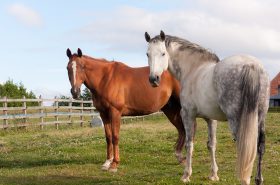You might need to wrap your horse’s legs for several different circumstances, such as with an injury, wound, during exercise, or for transport.
Though the materials you wrap with might be different for each of these circumstances, the basics of leg wrapping are the same.
Wrapping a horse’s legs can be beneficial for a number of reasons, including:
To provide support for tendons and ligaments during strenuous exercise;
To prevent or reduce swelling after exercise, injury, or during stall rest;
To protect legs from concussion and injury during shipping; and
To protect leg wounds from contamination and to encourage healing.
RULES FOR LEG WRAPPING
No matter the reason, there are two main rules that should always be followed when wrapping a
horse’s legs:
Wrap from inside to outside in order to prevent tendon damage. This means you should wrap
clockwise on right legs and counterclockwise on left legs.
Maintain the proper amount of tension as you wrap. Bandages that are too tight can restrict
blood flow and possibly cause damage to tendons or tissues. On the other hand, bandages
wrapped too loosely won’t provide effective compression.
STEP-BY-STEP GUIDE TO WRAPPING LEGS
Here are 10 basic steps for wrapping a horse’s leg:
Begin with a clean, dry leg.
If there is a wound, ensure that it has been cleaned and dressed appropriately.
For transport or support for wounds or injuries, first use a layer of padding with a thickness of an
inch or more. This will protect the leg beneath the bandage or wrap.
Begin wrapping at the inside of the cannon bone just above the fetlock.
Wrap clockwise on right legs and counterclockwise on left legs.
Wrap in a spiral pattern, going down the leg and up again, overlapping each layer by about 50%.
Use smooth, uniform pressure, ensuring there are no lumps or ridges beneath the wrap.
If using inner padding, wrap the top layer so that about half an inch of the padding shows at
both the top and bottom.
Ensure your wrap is securely fastened so that it will not easily come undone.
Allow the horse to become accustomed to their leg wrap before transport, exercise, or leaving
them alone in a stall.
If you’re completely new to wrapping a horse’s legs, it can be helpful to ask your veterinarian or
someone with experience to demonstrate the procedure first; then you can practice in front of
them to ensure you’re doing it correctly. With that said, wrapping a horse’s legs isn’t difficult and
is something you should be able to master in no time at all!



